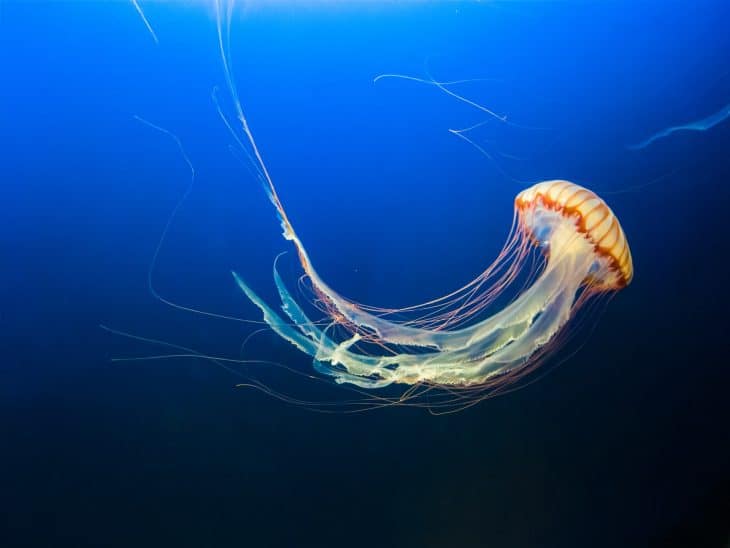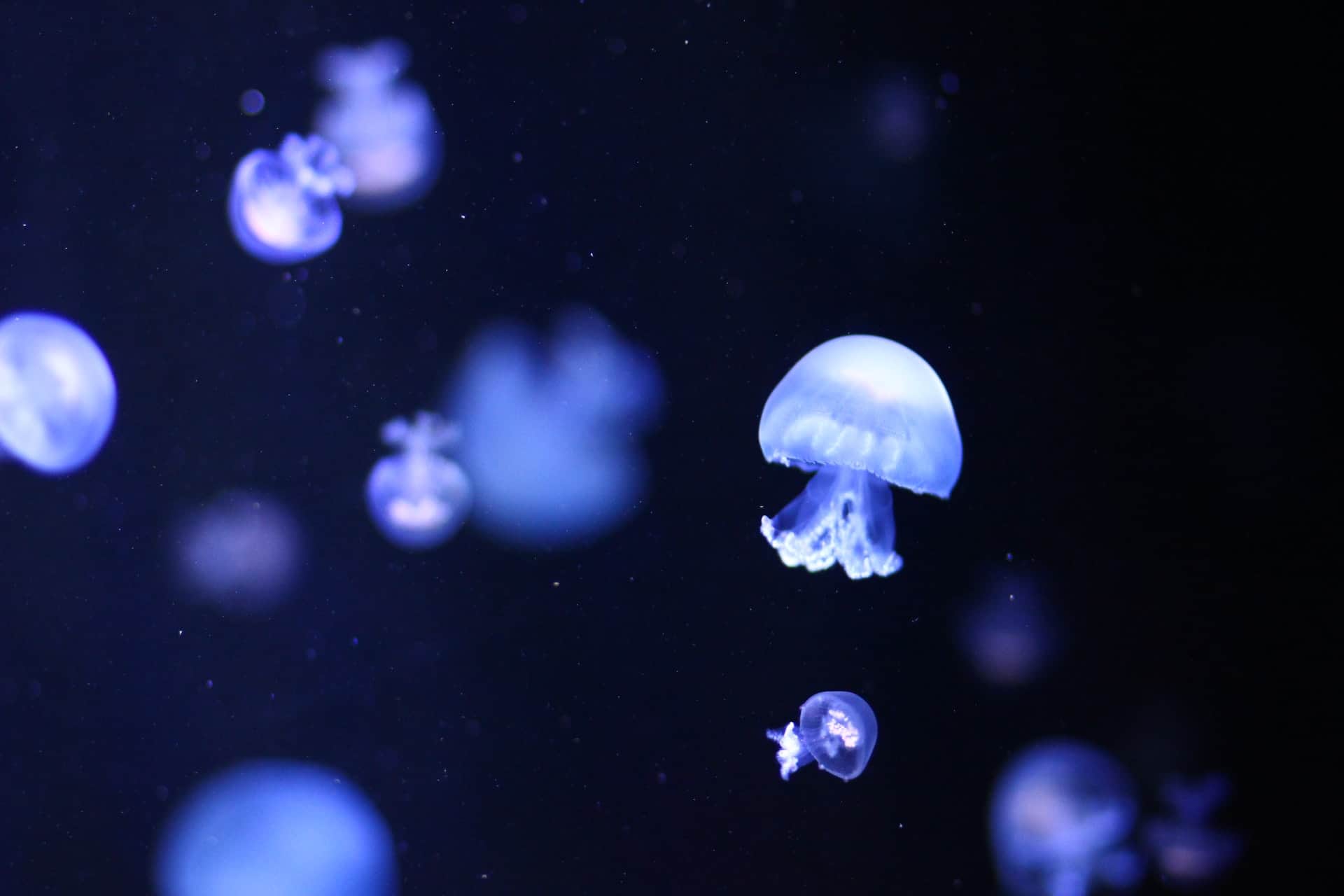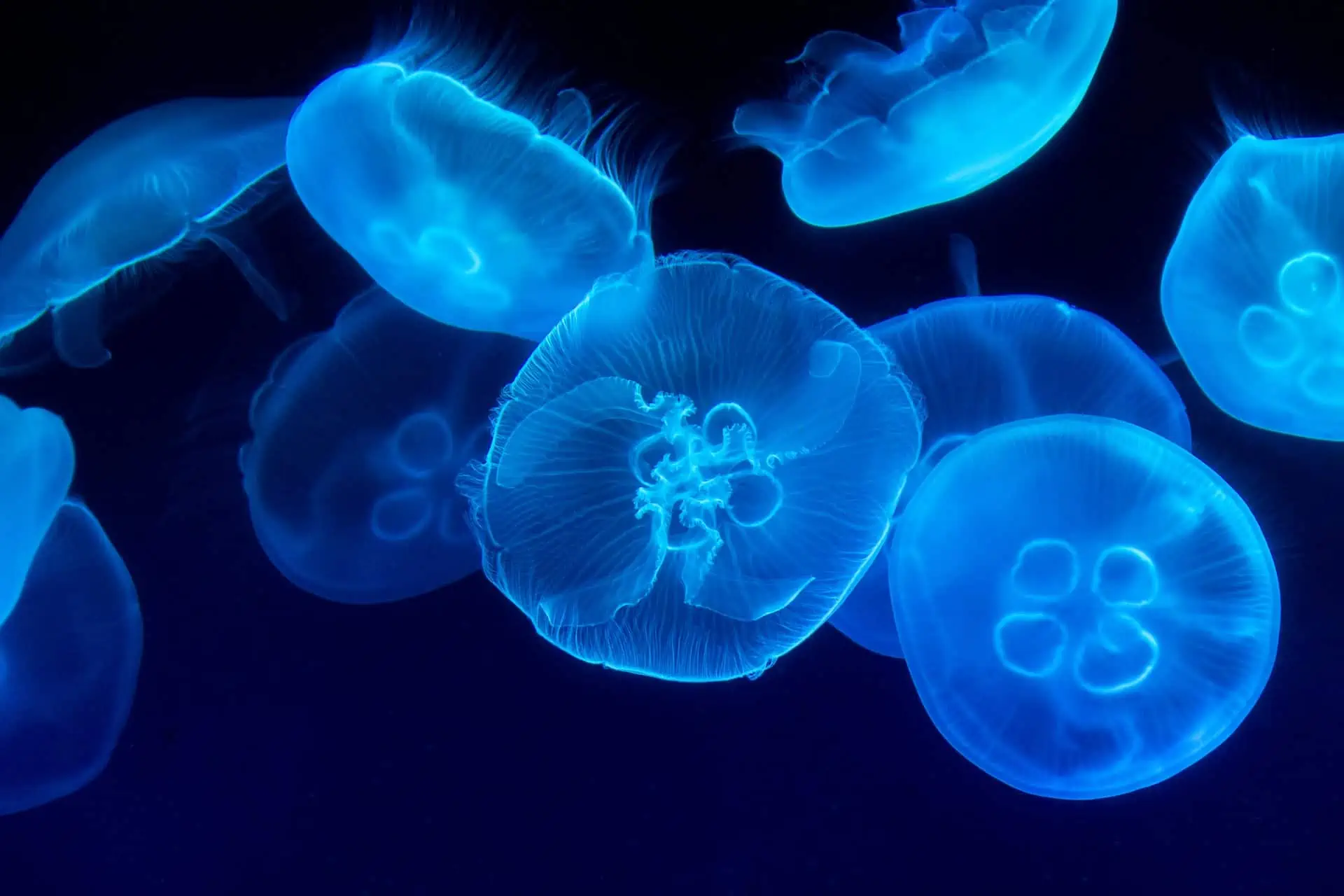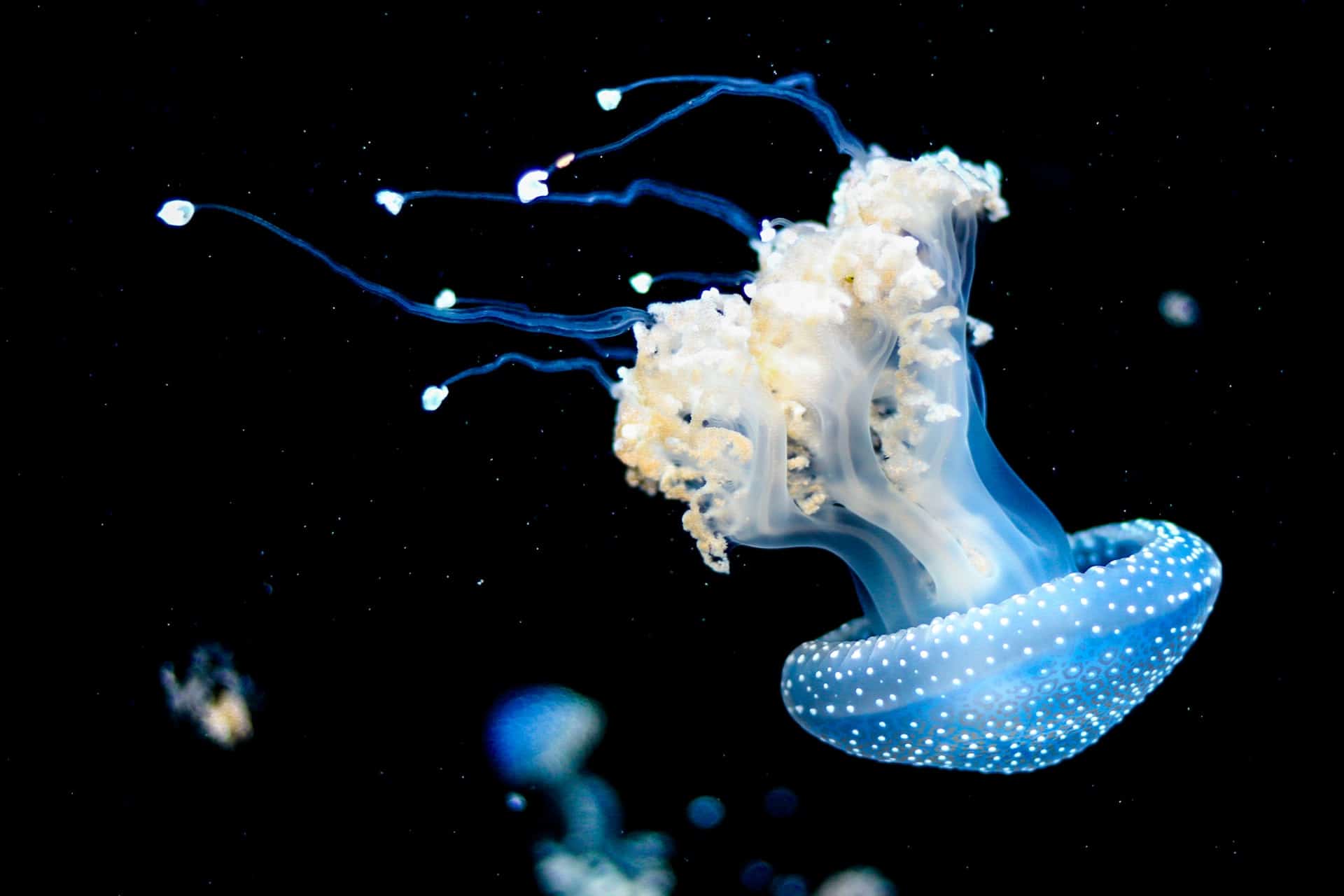
Jellyfish are among the coolest sea creatures. Even though they have a fairly simple body structure, they’ve got lots of unique characteristics. Did you know that jellies are 95% water? They have no blood, brains, and heart. How’s that for an initial set of jellyfish facts!
On the flip side, what they do have is a lot of venoms. The long tentacles trailing from the jellyfish body can inject a person with venom. They also use their created poison to capture their victims and sense their environment. The intensity of jellyfish stings varies greatly. Most of the time, they cause acute pain and irritated, red lines on the skin. Some jellyfish stings can result in systemic (whole-body) illness. Jellyfish stings can be life-threatening in some situations. The majority of jellyfish stings recover with home care. However, severe reactions require emergency medical care. You don’t want to make a jellyfish mad!
Here’s another interesting characteristic of the jellyfish, they are among the oldest species in the world, and they are still alive today. They’re also quite diverse: the phylum Cnidaria, which contains over 10,000 species, comprises the majority of jellyfish.
Want to know more about these fascinating gelatinous creatures? Why not take a few moments to enjoy some of these amazing jellyfish facts. What you will discover about these curiously charismatic gelatinous creatures may surprise you.
- The word jellyfish has been used since 1976. It is usually applied to medusae and all similar animals including the comb jellies.
- There are about 2,000 types of jellyfish.
- Most jellyfish span from less than half-inch, one centimeter, to 16 inches or 40 centimeters.
- Jellyfish have existed for more than 500 million years.
- Jellyfish sting thousands of swimmers every year.
- Jellyfish have tentacles.
- Their shape looks like a bell.
- They are made of a smooth, jelly-like body.
- Jellyfish come in different sizes.
- Most jellyfish live in saltwater while some live in freshwater.
- Jellyfish tentacles never get tangled.
- It has no hard parts.
- Some jellyfish are clear, but others come in different colors.
- Some jellyfish glow in the dark.
- Some small fish are invulnerable to a jellyfish sting, they even live within their tentacles.
- Vinegar and salt may help lessen the severity of a jellyfish sting.
- A group of jellyfish is called a “smack.”
- Jellyfish do not intentionally attack humans, they only attack if they are touched.
- A large quantity of jellyfish can tear fishing nets.
- They existed before dinosaurs.
Jellyfish is not a fish.
Though its name is jellyfish, it is not a fish. Fish is a vertebra, while jellyfish is an invertebrate. They don’t have a brain, backbone-or central nervous system. Jellyfish is a species that belongs to the phylum or class “Cnidaria,” animals that have stinging cells. In addition to this, “jellies” or “sea jellies” are introduced to minimize the use of the word fish.
Jellyfish have thousands of stinging cells.
Jellyfish have stinging cells located on their tentacles. Stinging cells are full of venom. Jellyfish use these cells to protect themselves from attackers. When tentacles are touched and triggered, stinging cells release venom that penetrates the skin of the predator. They also use the very venom to capture their victims.
Jellyfish eat almost anything in the water.
Jellyfish eat different types of food. They eat other marine creatures like small fish, larvae, eat crabs, shrimps, and tiny plants. They even eat other jellyfish.
Crystal jellyfish is totally colorless.
Crystal jellyfish is one of the largest types of jellyfish found in the western part of North America. Its bell size is around 15 centimeters or 5 inches. These jellies have about 150 long tentacles, and their tentacles have stings, but are not harmful to humans. By expanding their mouth, they can swallow another jellyfish half of their size.
Lion's mane jellyfish is one of the biggest known types.
Lion’s mane jellyfish or giant jellyfish is one of the largest jellyfish in the world. It can grow up to 2 meters or 6 feet and 7 inches. It is color orange or tan, just like a lion’s mane. Its “manes” are composed of thousands of tentacles divided into 8 clusters. Each cluster has about 70-150 tentacles. Moreso, the lion’s mane tentacles are very harmful.
Box jellyfish is highly poisonous.
Box jellyfish are named so because of their cube-like shape. Their tentacles are covered by poison, which can be fatal as it could cause cardiac arrest in humans. Box jellyfish populate the northern Australian coasts and the Indo-Pacific Ocean. They can swim as fast as 1.5 to 2 meters per second.
Turritopsis dohrnii is an immortal jellyfish.
Cool jellyfish facts! Just like other jellyfish, Turritopsis dohrnii also called the immortal jellyfish begins as a larva that turns into a fertilized egg. This jellyfish matures in a matter of weeks and is about 4.5 millimeters wide.
Turritopsis don’t just live for a long time, they have eternal life. In response to maturity or physical damage, they just go back to their development stage or begin again as a polyp (the stage when they attached to coral reefs).
Some jellyfish are edible.
Several types of jellyfish are fit for food consumption and can be used as ingredients in making different dishes. Jellyfish are processed into a dried product. Moreover, salad, noodles, sushi are just some of the dishes that may be prepared using jellyfish.
Jellyfish is 95% water.
In the water, a jellyfish looks squishy, but out of the water, it appears just like a blob or a water droplet. It is because jellies are 95% water. It has no blood, brains, and heart. If carried on the beach shore, jellies will evaporate and disappear.

Jellyfish have various predators.
Some jellyfish species also prey on jellies. Aside from them, sea anemones or sea flowering plants also eat jellyfish that deviate from their range. Other predators of jellyfish are sharks, sea turtles, penguins, tunas, and swordfish. Foxes and mammals also eat jellyfish are they washed on the beach.
Jellyfish has just one opening for eating and pooping.
Jellyfish use their tentacles to capture prey and transport food to their mouths. Their mouths are in the center of their bell-like body, it is just a small opening. They use their mouths to eat food and to release waste. And if they can’t get any weirdly cool, jellyfish squirt to propel themselves in the water.
Jellyfish lifespan varies.
A sea jelly’s life span depends on different factors. First is their type. Some jellyfish have a life span of 12 to 18 months; others live only for about three months to a year; some have a life period of three to six months. Other factors like water temperature, weather, and predators also affect a particular jellyfish’s life span.
Jellyfish reproduce sexually.
Medusa is the adult stage of jellyfish. Medusa or adult jellyfish reproduce sexually by spawning eggs and sperm cells that are deposited into the water. Female and male jellies release their egg and sperm cells through their mouths. Egg fertilization commonly happens in the water. However, in other species, sperms get into the mouth of the female jelly and fertilized within its body.
Jellies also propagate asexually.
After eggs are fertilized, jellyfish will undergo the polyp stage or the stage when jellyfish looks like a sea anemone. Polyps will hold to a smooth rock or surface. This stage may last for months or years. The polyp may reproduce asexually by cloning itself. The cloned polyp or a baby jellyfish is called ephyra.
Urine does not cure jellyfish sting.
As opposed to the myth, peeing on a jellyfish sting does not alleviate pain. One way to lessen the pain is to remove the tentacles using tweezers. Additionally, soaking the stung area in hot water may also make it feel better.
Even without eyes, jellies can still sense their environment.
Jellyfish has a simple body structure. Most species don’t have eyes. But they can detect light and sense their environment through the nerve net attached at the end of their tentacles. This nerve net is spread apart on their tentacles.
Box jellyfish have 24 eyes.
Box jelly has another distinct characteristic. These jellies have 24 eyes, their eyes are bundled into four groups, located at each corner of their bell-liked body. Two of the eye types can form images, while the other two types are to perform simpler tasks like responding to light and avoiding obstacles.
NASA sent over 2000 polyps to space.
In 1991, NASA sent over 2,000 polyps or anemone-like jellyfish to outer space. The experiment aimed to study how the lack of gravity will affect the development of jellyfish.
The jellies are kept in flasks and bags with artificial seawater. In addition, astronauts injected jellyfish with chemicals that will encourage them to reproduce.
Some jellies have bioluminescent organs
The majority of all types of jellyfish can produce bioluminescence or the creation and discharge of light of a species. Their bioluminescent organs make them glow in the dark. Furthermore, they are more visible in the deep ocean, these colors may be red, yellow, violet, and blue.

Jellies’ bioluminescence has different uses.
One main use of jellyfish’s bioluminescence is for self-defense. They use this light to scare or to confuse predators that might come their way. On the flip side, they also use their bioluminescence to attract and lure their prey. With their bright glow, they sometimes look like zooplankton, (small sea animals), which makes it easy for them to lure their prey.
Jellyfish can shut down nuclear power plants.
Nuclear power plants have been dealing with the jellyfish problem for quite a long time. This is because nuclear power plants use water from the ocean. Jellyfish clog the nuclear plant’s cooling intakes. When cooling water stops flowing, turbines will not work properly which will cause plants power reductions or shutdowns.
Dead jellyfish can still sting.
Be careful when touching or getting into contact with a dead jellyfish. Even if they are long dead, the venom on their tentacles is still prevalent and can cause harm. Their tentacles will continue to release poison until they are removed.
Jellyfish have high nutritional content.
Some types of jellyfish are safe to eat. In addition, each type has different amounts of nutritional content. According to a source, jellies have low calories but are a good source of protein, antioxidants, and other important minerals. A cup of dried edible jellyfish contains; 3 grams of protein; 7% of iron; 1 gram of fat and other nutrients like calcium, magnesium, and phosphorous.
Stygiomedusa is a rarely seen jellyfish species.
Stygiomedusa is a giant jellyfish. It is infrequently seen or only been spotted 118 times for around 110 years. However, it is believed that this type of jelly is common worldwide. It is one of the largest invertebrates. In addition, it has 4 long arms up to 10 meters long, which they use to catch prey.
Jellyfish can adjust to environmental changes.
According to research, jellyfish have the ability to adjust to environmental stress like climate change, water pollution, and warming seas. Unlike other marine creatures, they can adapt to low oxygen levels. Interestingly, the construction structures that placed in water such as oil platform, artificial reefs, piers, and others can also be a good habitat for jellyfish.
Jellyfish wiped out a salmon farm in Northern Ireland.
In 2007, a smack of jellyfish called “mauve stinger,” purple-striped jellyfish, attacked a Northern Ireland salmon farm. These jellies destroyed about a million pounds or $2.06 million worth of stock. The jellyfish covered the area for about 10 square miles, suffocating an average of 100,000 fish.
Jellyfish kill more humans than sharks.
Sharks are definitely terrifying, but would you believe that jellyfish kill more people than sharks do? According to reports, jellies are more likely to kill people than sharks. They can cause 40 deaths annually or larger than shark-related fatalities (about 13 in the year 2020). This is because jellyfish are highly poisonous and difficult to avoid.
Researchers from Sydney discovered antivenom for box jellyfish.
Researchers from the University of Sydney, Australia have discovered an antidote for the box jellyfish. They confirmed that the antivenom could stop necrosis, pain, and skin scaring. However, they need to do further studies if the antidote will stop heart attacks from occurring.

Jellyfish shoots its sting as fast as 700 nanoseconds.
Jellyfish can release their sting faster than a sports car and a bullet. It only takes 700 nanoseconds for a jellyfish to shoot using its stings and hit its target. Jellyfish, corals, and sea anemones have different ways of shooting their stings.
In the film Seven Pounds, the main character killed himself with a box jelly sting.
In the 2008 American drama film Seven Pounds, the character Ben Thomas killed himself using the venom of the box jellyfish. He did this in order for him to donate his organs to seven people. Though it has less-than-favorable reviews, it was a box-office hit, with a gross of US $168,168,201 worldwide.
Was this page helpful?
Our commitment to delivering trustworthy and engaging content is at the heart of what we do. Each fact on our site is contributed by real users like you, bringing a wealth of diverse insights and information. To ensure the highest standards of accuracy and reliability, our dedicated editors meticulously review each submission. This process guarantees that the facts we share are not only fascinating but also credible. Trust in our commitment to quality and authenticity as you explore and learn with us.
